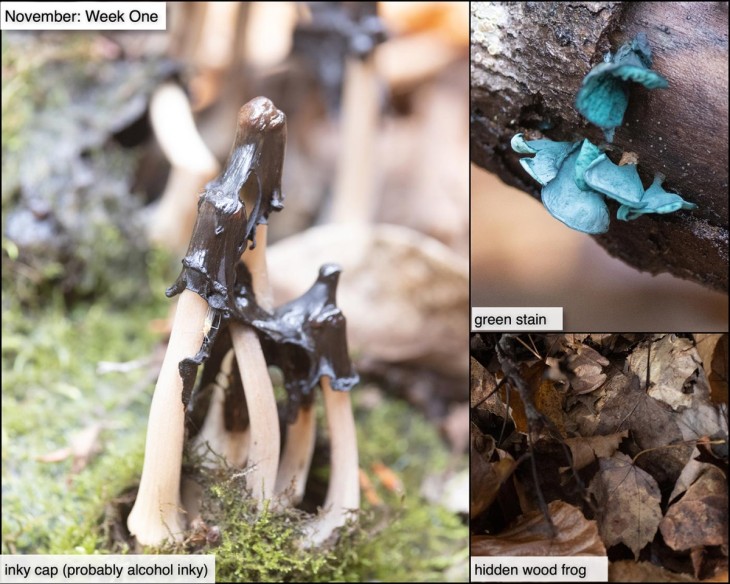This week in the woods, we discovered a gooey mess, and also an excuse to use the word deliquescence. The word, as applied to fungi, describes a process of self-destruction in which a mushroom releases enzymes that liquify its tissues, thereby freeing its spores. This process happens remarkably rapidly (sometimes within just a few hours) and can give the weird impression of one mushroom with multiple stems, as caps melt into each other.
Although it’s hard to be sure which species of deliquescent mushrooms are shown here, because we found them in an already advanced stage of decomposition, our best guess is that they’re specimens of Coprinopsis altramentaria, also called alcohol inky and tippler’s bane. It has these common names because it contains a toxin, coprine, that appears to be harmless to humans...unless it’s consumed within a few days of drinking an alcoholic beverage. We wrote about alcohol inky back in this September 2020 post (which shows mushrooms at a slightly earlier, more intact stage), and included a description of the symptoms that result when these mushrooms and alcohol mix, from writer Rachel Feltman for New York University’s Scienceline student magazine. “You might think it can’t be all that bad, but I have it on good authority that it really, really is,” she said. “Trust me, mycologists in grad school will try anything once…”
Another surprising fungal find this week was a cluster of large (thumbnail size) green stain fruiting bodies. It’s relatively uncommon to see these; more often you see the blue-green patches of color in rotting wood, hence the name. According to Lawrence Millman, in Fascinating Fungi of New England, one of the chemicals that causes this unusual blue-green color is of interest to researchers as a possible anti-carcinogen. Some woodworkers also incorporate green-stained wood into their projects.
There’s a frog in this photo. Can you find it? Wood frogs aren’t hopping as high as they do in warm weather, and they’ll soon disappear under the leaves. This most northern living frog, with a range extending into the Arctic Circle, survives severe cold through a natural kind of antifreeze. As temperatures drop, wood frog blood sugars push water out of the cells to the spaces between them, where the water can freeze without destroying tissues. One of Northern Woodlands’ first ever Outside Story articles addressed this subject. Here’s that December 2002 post by Tii McLane.
What have you noticed in the woods this week? Submit a recent photo for possible inclusion in our monthly online Reader Photo Gallery.



Discussion *